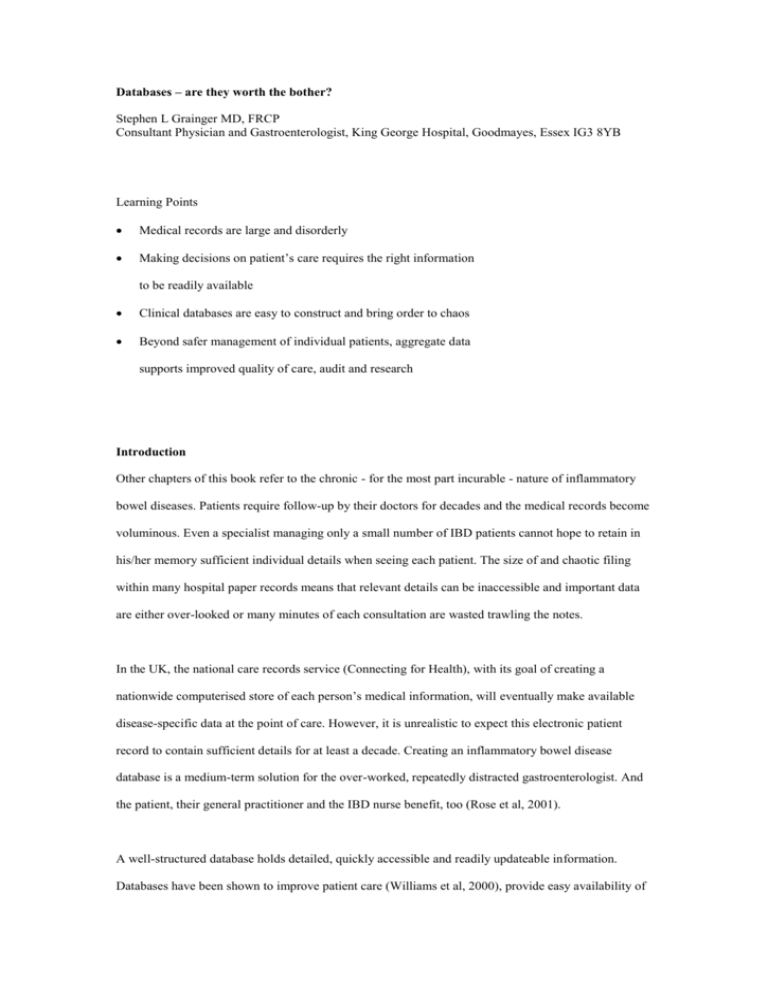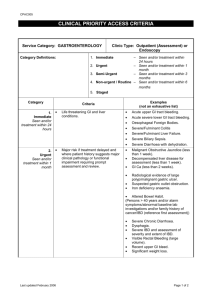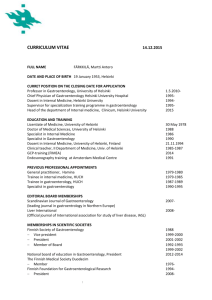Databases – are they worth the bother
advertisement

Databases – are they worth the bother? Stephen L Grainger MD, FRCP Consultant Physician and Gastroenterologist, King George Hospital, Goodmayes, Essex IG3 8YB Learning Points Medical records are large and disorderly Making decisions on patient’s care requires the right information to be readily available Clinical databases are easy to construct and bring order to chaos Beyond safer management of individual patients, aggregate data supports improved quality of care, audit and research Introduction Other chapters of this book refer to the chronic - for the most part incurable - nature of inflammatory bowel diseases. Patients require follow-up by their doctors for decades and the medical records become voluminous. Even a specialist managing only a small number of IBD patients cannot hope to retain in his/her memory sufficient individual details when seeing each patient. The size of and chaotic filing within many hospital paper records means that relevant details can be inaccessible and important data are either over-looked or many minutes of each consultation are wasted trawling the notes. In the UK, the national care records service (Connecting for Health), with its goal of creating a nationwide computerised store of each person’s medical information, will eventually make available disease-specific data at the point of care. However, it is unrealistic to expect this electronic patient record to contain sufficient details for at least a decade. Creating an inflammatory bowel disease database is a medium-term solution for the over-worked, repeatedly distracted gastroenterologist. And the patient, their general practitioner and the IBD nurse benefit, too (Rose et al, 2001). A well-structured database holds detailed, quickly accessible and readily updateable information. Databases have been shown to improve patient care (Williams et al, 2000), provide easy availability of aggregate data for audit and research and, if shared across many institutions, provide a powerful tool for assessing quality and outcome of care (Black et al, 2004). A number of departments of gastroenterology in the UK and elsewhere hold clinical information about their patients with IBD on computers. Many use this information for research purposes or to measure activity. Fewer use this potentially rich store of information for the day-to-day management of individual patients in clinics or on the wards – the real value of a clinical database. Benefits of data bases Benefits in managing patients with chronic disease are available to all members of the health-care team: For the doctor synopsis of essential information, available at the point of care without having to ‘mine’ the paper record. relevant clinical information is available even when the hospital paper record is lost. can provide graphical trends in disease activity to inform decisions on medical management or need for surgery. displays duration of treatments (eg steroids, immunosuppressants) enabling potential harm to be minimised. For the patient confidence their doctor/nurse knows all the necessary details of their illness. can be structured to produce a patient-held record consisting of a disease summary and treatment – of particular value to patients when travelling or attending a hospital unfamiliar with their case. the database can be built to provide prompts and safety alerts. For example: interval since last colonoscopy, to facilitate appropriate timing of surveillance procedures; identification of patients on steroids who are not receiving treatment to minimise bone injury; etc. For the specialist nurse facilitates protocol guided care. provides readily available information when responding to patients’ enquiries without the need to locate the paper record. supports postal, telephone or open-access follow-up of patients. facilitates monitoring of the nurse’s own activity. For the general practitioner enables the automatic production of letters to general practitioners following consultations. speeds up out-patient clinics creating time for new referrals to be seen. can be constructed to allow the general practitioner access to the database. For audit and research creates a disease register automatically as a by-product of patient care. facilitates “look-back”. For example: all patients on immunosuppressants for more than four years; any patient with dysplasia detected at colonoscopy; etc. identification of patients with specific disease characteristics suitable for inclusion in clinical studies. allows studies to be performed using data collected within the database, avoiding the need for purpose-designed forms (Hutchings et al, 2005). Creating an inflammatory bowel disease clinical database Most databases have been created by enthusiasts and are used in individual departments, but there are one or two commercial offerings that have been developed in liaison with clinicians. An international database originating in Austria has growing exposure and is targeted particularly at recruitment to clinical trials and at accumulating aggregate data (IBDIS). The very large number of data items collected on each patient make this database less suitable for day-to-day care of individual patients. The wide availability of computer skills and database software mean that “home grown” databases are readily developed. This individual approach does not facilitate exchange of data between separate hospitals but is a quick and practical way of getting going. If the database uses common terminology derived from the nationally mandated coding system, SNOMED-CT, sharing of information between departments of gastroenterology becomes feasible. The British Society of Gastroenterology is assisting the UK national programme in developing a complete list of the clinical terms in use in the care of patients with inflammatory bowel disease. These terms should form the basis for the fields of a clinical database. By including clinical decision support in the database, further improvements in patient care and reduction of medical errors can be attained (Kawamoto et al, 2005), at the expense of increasing the level of complexity in creating the database. Populating the database Once designed and built, the database only becomes useful when populated with patients’ details. The ideal approach is to acquire patient data prospectively but usually there will be a large number of existing patients whose data must be added retrospectively. For the same reason that the database is so valuable it can be very time-consuming extracting the relevant information from each patient’s paper record. The skills of the IBD specialist nurse make him/her ideal for this task, which requires a depth of knowledge rarely found in administrative assistants, but the tedium of the task must be acknowledged and the time necessary made available. Entering details becomes quicker and easier with practice and updating information at the time of each patient contact should take only a minute or two. The benefits to the patient and the whole health-care team make this effort ultimately rewarding. Disadvantages of data bases There are some drawbacks to single disease clinical databases. Patients often have many medical problems and focussing only on the details held in the database can mean other diseases are overlooked. Countering this by creating specific databases for each possible disease becomes logistically impossible to manage. In time, Connecting for Health, by providing access to each UK citizen’s health record, will overcome these limitations and make IBD (and all other disease-specific) databases unnecessary. Conclusions The greatest benefit of an IBD database is the instant availability of all essential information when seeing a complex patient, facilitating a department’s delivery of effective care (Williams et al 2000), with the potential to reduce errors (Kawamoto et al, 2005). Beyond this, the adoption of agreed terminology in a standard database used by many institutions holds the potential to provide access to comparable data (anonymised, if necessary) on very large numbers of patients for epidemiological and intervention studies. Health care is a complex task that requires accurate decision-making based on interpretation of many pieces of information. Computer databases hold the key to easy access to this information, presented in an orderly manner (see screen shot), and will become indispensable for high quality care. Acknowledgments I am grateful to Professors John Williams and Jonathan Brown for helpful discussions, and to Sister Juliet Rose for maintaining our own IBD database. References Black N, Barker M, Payne M. Cross sectional survey of multicentre clinical databases in the United Kingdom. BMJ 2004;328:1478-81. Connecting for Health. http://www.connectingforhealth.nhs.uk/ (accessed 25 May 2005) Hutchings HA, Cheung WY, Williams JG, Cohen D, Longo MF, Russell IT. Can electronic routine data act as a surrogate for patient-assessed outcome measures? Int J of Technology Assessment in Health Care 2005;21(1):133-8. IBDIS. http://www.ibdis.net/project/index.asp (accessed 25 May 2005) Kawamoto K, Houlihan CA, Balas EA, Lobach DF. Improving clinical practice using clinical decision support systems: a systematic review of trials to identify features critical to success. BMJ 2005;330:765-8. Rose J, Dunne I, Grainger SL. An electronic patient record for inflammatory bowel disease: helping patients and doctors. Gut 2001;(Suppl 1)48:A87. Williams JG, Cheung WY, Russell IT, Cohen DR, Longo M, Lervy B. Open access follow up for inflammatory bowel disease: pragmatic randomised trial and cost effectiveness study. BMJ 2000;320:544-8. Screen shot of Inflammatory Bowel Disease database (IBDbase)









